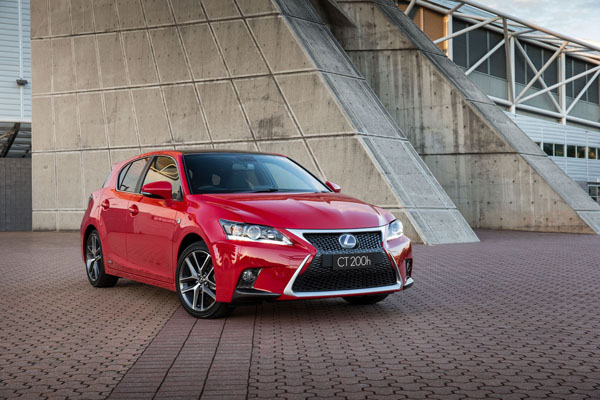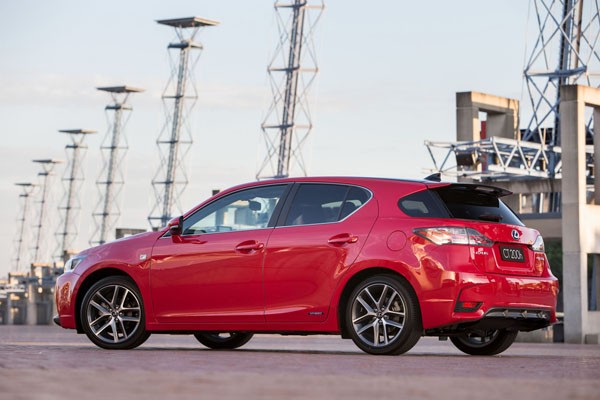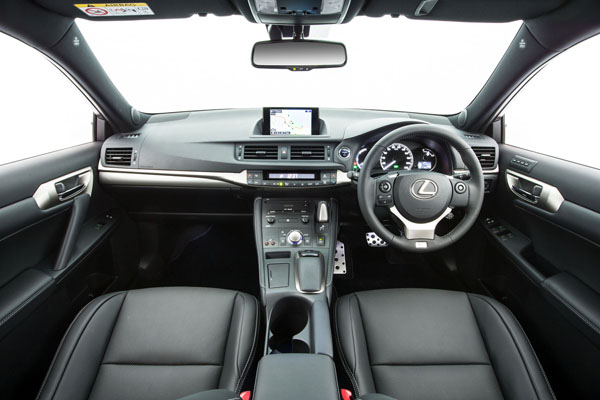
Lexus has given its CT200h hybrid a major facelift, tightened up the body to improve noise and vibration suppression, but, surprisingly, hasn’t changed the drivetrain components.
STYLING
There’s no harder fought market in the luxury vehicle segment than that of small to medium cars. Lexus CT200h is up against the all-new Mercedes-Benz A-Class, the Audi A1 and BMW’s 1 Series. Buyers from the Mercedes C-Class, Audi A3 and BMW 3 Series may also be taking a look at the Lexus CT range.
Once upon a time buyers of the big-three German marques were on the conservative side. Now, buyers in the small car segment are increasingly demanding styling that’s out there. The original Lexus CT200h didn’t fill that bill, but the facelifted model has leapt away from the ordinary, perhaps taking cues from the radical shape of the front end of the A-Class.

Lexus’ ‘spindle-grille’ theme, applied to many other models from the upmarket Japanese marque in the last couple of years, reaches new heights (and new widths and depths) in the CT200h. It comes in two distinct finishes, our favourite being that used in F Sport, with its distinctive mesh grille. The latter also features a black roof.
There are also new-design alloy wheels, revised rear lights and a restyle of the rear bumper. The standard models get a smallish rear roof spoiler, the F Sport a much larger unit.
The overall effect is a bold look that certainly gathered a fair bit of attention during the introductory drive program put on by Lexus as part of the media launch in inner-city and northern suburbs of Sydney.

Inside there are new trim colours and materials. Satellite navigation with Suna traffic information is standard on some, optional on others. May we suggest contacting your local Lexus dealer for information on the expanded range of features and accessories on offer?
ENGINES / TRANSMISSIONS
A big surprise is that there are no changes here. There are obviously bigger advances being made in hybrid technology than in conventional engines and transmissions, so why not adopt the latest in hybrid technology to the facelifted Lexus CT200h? Lexus won’t comment on this and we can only assume that big things await us when the all-new model is launched, probably in 2016 or 2017.
The hybrid petrol-electric system produces up to 100 kilowatts of power and drives through a clever CVT automatic transmission.
SAFETY
All Lexus CT200h models now have a reversing camera. They benefit from additional body strengthening and the use of no fewer than eight airbags, including units to protect the driver’s and front passenger’s knees. The small Lexus had no trouble gaining a five-star crash test rating.
DRIVING
Always a quiet, smooth car in the tradition of all Lexus models, the CT200h ha been further improved by the use of a stronger body, which permits softer suspension settings. The steering has been improved and while you wouldn’t really call it a sports hatch, even in F Sport format, the CT200h is pleasant to drive and ride in.
There’s some road noise on coarse-chip surfaces, though we’ve heard worse.
SUMMING UP
The revised Lexus CT200h is a surprise package. Improvements to the body and suspension make it even quieter and more pleasant to travel in.
Driver involvement is increased thanks to the tauter body and the softer suspension settings that complement one another. On the other hand using the same drivetrain as before surprises us.
GOVERNMENT INACTION
Despite cross examination at the press launch, Lexus chiefs in Australia refused to criticise the Australian governments for their lack of assistance in making clean full-electric or partial-electric vehicles more affordable and desirable to consumers. Simply making statements like, “These things take time, it’s a complex subject.”
In other countries governments have given assistance for many years. Numerous methods are used; lower sales taxes, cheaper registration fees, even free parking in major cities.
Even something simple like letting electric and hybrid vehicle use transit lanes without the usual restrictions, as happens in the USA for example, would cost nothing in the way of lost revenue to our governments.
In Australia, nothing is being done. Why not?











